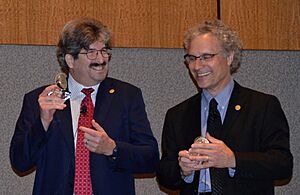Gary Ruvkun facts for kids
Quick facts for kids
Gary Ruvkun
|
|
|---|---|

Ruvkun in 2024
|
|
| Born | March 26, 1952 Berkeley, California, U.S.
|
| Alma mater | University of California, Berkeley (BA) Harvard University (PhD) |
| Awards |
|
| Scientific career | |
| Institutions | University of California, Berkeley Harvard University Massachusetts Institute of Technology Massachusetts General Hospital |
| Thesis | The molecular genetic analysis of symbiotic nitrogen fixation (NIF) genes from rhizobium meliloti (1982) |
| Doctoral advisor | Frederick Ausubel |
Gary Bruce Ruvkun (born March 26, 1952) is an American scientist. He works at Massachusetts General Hospital and teaches genetics at Harvard Medical School in Boston.
Ruvkun is famous for his discoveries about tiny molecules called microRNAs. These molecules help control how our bodies work. He found out how one microRNA, called lin-4, controls other genetic messages. He also discovered another important microRNA, let-7, and showed that it is found in many animals, including humans.
His work helped scientists understand a whole new way that genes are controlled. He also found out how signals like insulin affect aging and how our bodies use energy. In 2024, Gary Ruvkun won the Nobel Prize in Physiology or Medicine. He shared this award for his discoveries about microRNA and how it controls genes.
Contents
Early Life and Education
Gary Ruvkun was born on March 26, 1952. His parents were Samuel and Dora Ruvkun.
He went to the University of California, Berkeley. In 1973, he earned a degree in biophysics. This field combines biology and physics.
Later, he studied at Harvard University. He received his PhD in biophysics in 1982. For his PhD, he studied how bacteria use genes to fix nitrogen. After that, he did more research at Massachusetts Institute of Technology (MIT) and Harvard.
Amazing Discoveries
How lin-4 MicroRNA Works
Gary Ruvkun's research helped explain how a tiny molecule called lin-4 works. This molecule is a very small RNA that helps control genes. It was first found in 1992 by another scientist, Victor Ambros.
Ruvkun found that lin-4 controls a target gene called lin-14. It does this by matching up with parts of the lin-14 gene's message. This matching is not perfect, but it helps to slow down or stop the production of the lin-14 protein.
His work showed that these tiny RNAs control genes in a new way. This discovery opened up a whole new area of science. It helped us understand how microRNAs work to control what proteins our cells make.
The let-7 MicroRNA
In 2000, Ruvkun's lab found a second microRNA in a tiny worm called C. elegans. They named it let-7. Like lin-4, let-7 also controls a target gene by matching up with its message.
A very important discovery was that let-7 is found in many different animals. This includes humans! This showed that microRNAs are important for life across many species. It also suggested that there were many more microRNAs to be found.
MicroRNAs and Gene Control
Scientists later found other small RNAs called siRNAs in plants. These siRNAs were similar in size to microRNAs. This made scientists wonder if they worked in similar ways.
Ruvkun's lab worked with other scientists to show that microRNAs and siRNAs use similar tools in the cell. They found that certain proteins, like Dicer, are used by both types of small RNAs. In the years that followed, Ruvkun's lab found many more microRNAs. They also discovered new proteins that help microRNAs do their job.
How Genes Affect Aging and Energy
Ruvkun's lab also found that a pathway similar to how insulin works controls aging and energy use in C. elegans worms. Insulin is a hormone that helps control blood sugar in humans.
They discovered genes that affect how long the worms live. These genes are similar to genes found in humans. This research is important for understanding aging and diseases like diabetes. His lab has also found many genes that control aging and metabolism. These discoveries could help in developing new medicines.
Searching for Life Beyond Earth
Gary Ruvkun's lab is also working on a project called SETG. This stands for "Search for Extraterrestrial Genomes." They are building small tools that can find and read DNA and RNA on other planets.
The goal is to send these tools to places like Mars. They want to see if there is any life there. If they find DNA, they can compare it to life on Earth. This could help us learn if life started on Earth or somewhere else in the universe.
How Our Bodies Fight Germs
In 2012, Ruvkun made an important discovery about how our bodies fight off infections. He found a clever way that animals can detect germs. Our bodies watch for changes in normal cell functions. Germs often try to mess up these functions with their toxins. By noticing these changes, our bodies can tell when there's an infection.
Awards and Recognition

Gary Ruvkun has received many awards for his important work in science. These awards recognize his discoveries about microRNAs and his contributions to understanding aging.
Some of his major awards include:
- 2008: Gairdner Foundation International Award
- 2008: Benjamin Franklin Medal in Life Science
- 2008: Lasker Foundation Award for Basic Medical Research
- 2014: Wolf Prize in Medicine
- 2015: Breakthrough Prize in Life Sciences
- 2024: Nobel Prize in Physiology or Medicine
He was also chosen to be a member of the United States National Academy of Sciences in 2008.
See also
 In Spanish: Gary Ruvkun para niños
In Spanish: Gary Ruvkun para niños
- List of Jewish Nobel laureates

